Solvay Process Company
| Chemical Manufacturing | |
| Industry | Chemicals |
| Fate | Purchased by |
| Founded | 1880 |
| Founder | Joint venture between chemists, Belgians Ernest and Alfred Solvay, who owned the patent rights to the Solvay process, and Americans William B. Cogswell (1834–1921) and Rowland Hazard II (1829–1898) |
| Defunct | 1985 |
| Headquarters | Solvay, Onondaga County, New York, United States |
Area served | United States |
| Products | Soda ash |
| Parent | E. C. Stearns & Company |
The Solvay Process Company (1880–1985) was a pioneer chemical industry of the United States in the manufacture of soda ash and a major employer in Central New York. The company was the origin of the village of Solvay.
History
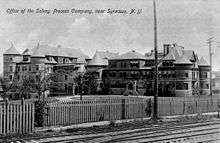
The Solvay Process Company was a joint venture between the inventing chemists, Belgians Ernest and Alfred Solvay, who owned the patent rights to the Solvay process, and Americans William B. Cogswell (1834–1921) and Rowland Hazard II (1829–1898). Cogswell, a former resident of Syracuse, New York, was an engineer who was familiar with the natural resources of Central New York that would be available for use in process. He was employed as a mining engineer by one of the Hazard family businesses at the time. Knowing that American industry was importing soda ash from Europe, Cogswell envisioned utilizing the process in America, and in Solvay, New York.
After several refusals, Cogswell secured American rights to the Solvay process. He obtained capital to build a production facility from Roland Hazard II, scion of an old Rhode Island family. Roland Hazard was the major American investor in the company and its first president. His son, Frederick Rowland Hazard, was an initial officer and subsequently became president. William B. Cogswell served as vice-president. Frederick's brother Rowland G. Hazard II (1855–1918) followed Cogswell as vice-president, serving many years in that role.

The Solvay brothers in Belgium had a one-third interest in the company. To produce soda ash, the Solvay process requires salt brine and limestone, both obtained locally. Wells in the town of Tully provided salt brine, pumped by pipeline to Solvay. An elevated conveyor, with buckets suspended from a cable loop, passed in a tunnel through a hill [1] [2] [3] to deliver stone from company quarries at Split Rock, in the Town of Onondaga, about four miles to the south.
The Erie Canal passed through the Solvay Process plant, providing water transport, as did subsequently Onondaga Lake, connected to the New York State canal system. The main line of the New York Central Railroad also passed through company property, providing transport.
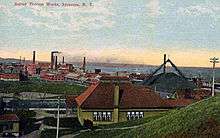
The village grew around the Solvay Process plant. The Church and Dwight Company, producer of "Arm and Hammer Baking Soda," which used material from the Solvay Process, built a production facility nearby.
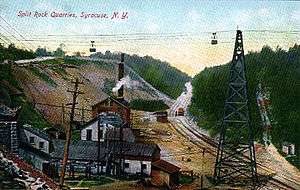
Waste beds
Large marshlands around the lake provided disposal for sludge from the process, leaving extensive "waste beds." These have contributed to pollution of the lake.
Semet-Solvay coke ovens
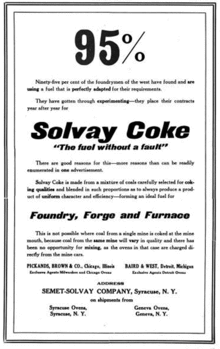
The Hazard family invested in an affiliated business, the Semet-Solvay Company, formed in 1895. Louis Semet, a relative of Ernest and Alfred Solvay, had developed with the brothers a coke oven designed to recover valuable materials formerly wasted in the coking process. In 1892 the Solvay Process Company built the first of the ovens in America, forming the Semet-Solvay Company three years later to build and operate them. Coke plants were located in Ashland, Kentucky; Buffalo, New York; Detroit, Michigan; and Ironton, Ohio. Semet-Solvay operated its own mines in West Virginia, providing much of its coal supply.
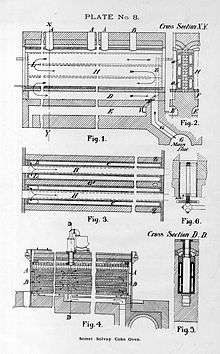
Absorption by Allied Chemical
Both the Solvay Process Company and the Semet-Solvay Company in 1920 were absorbed by the Allied Chemical and Dye Corporation, a merger promoted by chemist William Nichols and financier Eugene Meyer. William Henry Nichols had started a small sulphuric acid plant in 1870, and by 1900 controlled several chemical companies. Nichols was a founding member of the American Chemical Society in 1876, serving twice as its president, and is memorialized by the Nichols Medal for chemical research. Eugene Meyer, a financial genius, was publisher of the Washington Post. Nichols, having observed American dependence on German chemical production, hence vulnerability during World War I, envisioned consolidation and recapitalization of the American chemical industry. He shared this concept with Eugene Meyer, who had the financial capability to realize such a vision. Formed in 1920 and based in New York City, the Allied Chemical and Dye corporation combined five chemical companies. When proposed, the promoters assured the companies that each would retain autonomy of operations. The Hazard family soon recognized default on agreement with the promoters of the holding company. The family controlled not merely the Solvay Process Company, but also the second of the five companies merged into the new corporation, the Semet-Solvay Company (founded 1894) that manufacturing coke and its by-products.

Eugene Meyer persuaded Orlando Weber to take charge of Allied Chemical and Dye Corporation. An inscrutable man, Weber initiated an autocratic regime (1920–1935) which was successful financially, but at the cost of reversing previously agreed policy about company autonomy. The family attempted to gain a controlling interest by quietly acquiring large amounts of stock in the corporation. They failed to return operations of the plant to local control, or to enable reemployment of personnel terminated by the new corporation, contrary to agreement with the Hazard family. Members of the family remained in Solvay and subsequently in Syracuse and Cazenovia, New York. The family has been notable for active participation in reform movements and for philanthropy, such major gifts to the Syracuse Hospital for Women and Children, which became Memorial Hospital, now Crouse-Irving Hospital.
William B. Cogswell, vice-president of the Solvay Process Company, resided in a landmark mansion (1906) designed by Syracuse architect James A. Randall at 1234 James Street in Syracuse until Cogswell died in 1921. The large property became the residence of Roman Catholic bishops of the Diocese of Syracuse, but was destroyed by fire.
The Solvay Process Company plant at Solvay, New York closed in 1985 and was demolished.
References
- Solvay Process Company Records
- AlliedSignal History
- "Evamaria Hardin - Faculty Papers". Archived from the original on 2006-09-01. Hardin's papers include a "Solvay Process History".
- Company Archives
- Building blueprints, Solvay Library
- ↑ Northeast portal is at coordinates 43°03′07″N 76°13′03″W / 43.05188°N 76.21742°W
- ↑ Southwest portal is at coordinates 43°03′00″N 76°13′09″W / 43.05009°N 76.21925°W
- ↑ Tunnel is at coordinates 43°03′03″N 76°13′06″W / 43.05097°N 76.21840°W
External links
- William B. Cogswell
- Onondaga Lake Pollution History
- Onondage Lake, NYS DEC
- Honeywell and Onondaga Lake
- Kiefer, David M. (February 2002). "Soda Ash, Solvay Style". Today's Chemist at Work. American Chemical Society. 11 (2): 87–88, 90.
- Photograph of the administration and staff of Solvay Process Company ca. 1910 from the Schuelke Collection of the Liverpool Public Library
- Historic American Engineering Record (HAER) No. NY-300, "Solvay Process Company, Between Willis & Milton Avenues, Solvay, Onondaga County, NY", 8 photos, 1 photo caption page
- HAER No. NY-300-A, "Solvay Process Company, Lime Kiln Building", 9 photos, 1 photo caption page
- HAER No. NY-300-C, "Solvay Process Company, Milk of Lime Towers Building", 10 photos, 1 photo caption page
- HAER No. NY-300-D, "Solvay Process Company, SA Wetside Building", 21 photos, 3 color transparencies, 3 photo caption pages
- HAER No. NY-300-E, "Solvay Process Company, Refined Bicarbonate Building", 1 photo, 1 photo caption page
- HAER No. NY-300-F, "Solvay Process Company, Calcium Chloride Plant", 3 photos, 1 photo caption page
- HAER No. NY-300-G, "Solvay Process Company, North Power House", 2 photos, 1 photo caption page
- HAER No. NY-300-H, "Solvay Process Company, SHT Building", 9 photos, 1 photo caption page
- HAER No. NY-300-I, "Solvay Process Company, Dense Ash Building", 5 photos, 1 photo caption page